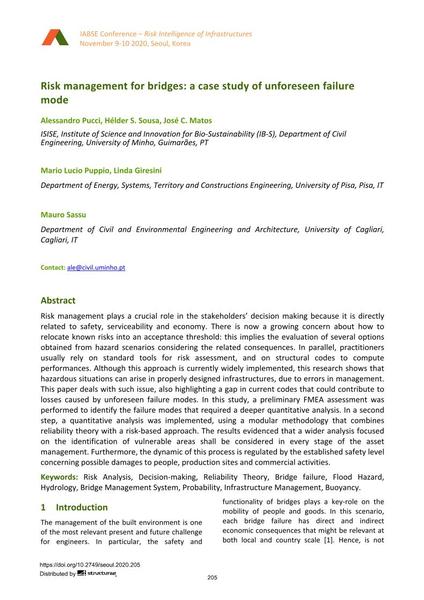Risk management for bridges: a case study of unforeseen failure mode

|
|
|||||||||||
Bibliographic Details
| Author(s): |
Alessandro Pucci
(ISISE, Institute of Science and Innovation for Bio-Sustainability (IB-S), Department of Civil Engineering, University of Minho, Guimarães, PT)
Hélder S. Sousa José C. Matos Mario Lucio Puppio (Department of Energy, Systems, Territory and Constructions Engineering, University of Pisa, Pisa, IT) Linda Giresini (Department of Energy, Systems, Territory and Constructions Engineering, University of Pisa, Pisa, IT) Mauro Sassu (Department of Civil and Environmental Engineering and Architecture, University of Cagliari, Cagliari, IT) |
||||
|---|---|---|---|---|---|
| Medium: | conference paper | ||||
| Language(s): | English | ||||
| Conference: | IABSE Conference: Risk Intelligence of Infrastructures, Seoul, South Korea, 9-10 November 2020 | ||||
| Published in: | IABSE Conference Seoul 2020 | ||||
|
|||||
| Page(s): | 205-213 | ||||
| Total no. of pages: | 9 | ||||
| DOI: | 10.2749/seoul.2020.205 | ||||
| Abstract: |
Risk management plays a crucial role in the stakeholders’ decision making because it is directly related to safety, serviceability and economy. There is now a growing concern about how to relocate known risks into an acceptance threshold: this implies the evaluation of several options obtained from hazard scenarios considering the related consequences. In parallel, practitioners usually rely on standard tools for risk assessment, and on structural codes to compute performances. Although this approach is currently widely implemented, this research shows that hazardous situations can arise in properly designed infrastructures, due to errors in management. This paper deals with such issue, also highlighting a gap in current codes that could contribute to losses caused by unforeseen failure modes. In this study, a preliminary FMEA assessment was performed to identify the failure modes that required a deeper quantitative analysis. In a second step, a quantitative analysis was implemented, using a modular methodology that combines reliability theory with a risk-based approach. The results evidenced that a wider analysis focused on the identification of vulnerable areas shall be considered in every stage of the asset management. Furthermore, the dynamic of this process is regulated by the established safety level concerning possible damages to people, production sites and commercial activities. |
||||
| Keywords: |
risk analysis probability buoyancy bridge management system infrastructure management decision-making Reliability Theory Bridge failure Flood Hazard Hydrology
|
||||
